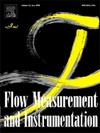插入式电导传感器测量油气水间歇流段塞区持水率
IF 2.3
3区 工程技术
Q2 ENGINEERING, MECHANICAL
引用次数: 0
摘要
水平间歇油气水段塞流区持水率测量对于理解界面传热传质和揭示流型转变机理具有重要意义。考虑到水平油气水间歇流的多尺度结构特征,设计了两个插入式电导传感器,用于段塞流区域的持水率测量。它们分别是分布式多电极电导传感器(DMECS)和环电极电导传感器(RECS)。利用有限元方法对传感器的几何形状进行优化,提高了探测场的灵敏度和均匀性。在直径为20mm的管道内进行了水平气水流动和油气水流动实验。收集两个电导传感器的响应信号。根据收集到的信号绘制递归图,以证明检测局部流结构的能力。研究了间歇流段塞区持水率的非均匀分布特征。此外,进一步探讨了油相对局部流动结构和持水率的影响。最后,将电导传感器测得的持水率与丝网传感器测得的持水率进行了比较。结果表明,RECS能反映平均持水率,而DMECS对局部持水率特征较为敏感。因此,DMECS对小尺度油滴和油泡具有更高的测量分辨率。通过对比,RECS对具有大尺度流场结构的伪段塞流具有较好的测量性能。本文章由计算机程序翻译,如有差异,请以英文原文为准。
Measurement of water holdup in slug region of oil-gas-water intermittent flow by plug-in conductance sensors
The water holdup measurement in the horizontal intermittent oil-gas-water flow slug region is of great significance for understanding interfacial heat and mass transfer and revealing the mechanism of flow pattern transition. Considering the multi-scale structural characteristics of the horizontal oil-gas-water intermittent flow, two plug-in conductance sensors are designed for the water holdup measurement in the slug region. They are distributed multi-electrode conductance sensor (DMECS) and ring-electrode conductance sensor (RECS). The finite element method is employed to optimize the geometries of the sensors to enhance the sensitivity and uniformity of the detection field. Experiments are conducted in horizontal gas-water and oil-gas-water flows within a 20 mm diameter pipe. Response signals from both conductance sensors are collected. Recurrence plots are drawn based on the collected signals to demonstrate the capability to detect local flow structures. The non-uniform distribution characteristics of water holdup in the intermittent flow slug region are studied. Besides, the influence of the oil phase on the local flow structures and water holdup is further explored. Finally, the water holdup measured by the conductance sensors is compared with the wire-mesh sensor. The results indicate that the RECS can reflect the average water holdup, whilst the DMECS is sensitive to the local water holdup characteristics. Thus, the DMECS has a higher measurement resolution for small-scale oil droplets and bubbles. By comparison, the RECS demonstrates better measurement performance for the pseudo slug flow with large-scale flow structures.
求助全文
通过发布文献求助,成功后即可免费获取论文全文。
去求助
来源期刊

Flow Measurement and Instrumentation
工程技术-工程:机械
CiteScore
4.30
自引率
13.60%
发文量
123
审稿时长
6 months
期刊介绍:
Flow Measurement and Instrumentation is dedicated to disseminating the latest research results on all aspects of flow measurement, in both closed conduits and open channels. The design of flow measurement systems involves a wide variety of multidisciplinary activities including modelling the flow sensor, the fluid flow and the sensor/fluid interactions through the use of computation techniques; the development of advanced transducer systems and their associated signal processing and the laboratory and field assessment of the overall system under ideal and disturbed conditions.
FMI is the essential forum for critical information exchange, and contributions are particularly encouraged in the following areas of interest:
Modelling: the application of mathematical and computational modelling to the interaction of fluid dynamics with flowmeters, including flowmeter behaviour, improved flowmeter design and installation problems. Application of CAD/CAE techniques to flowmeter modelling are eligible.
Design and development: the detailed design of the flowmeter head and/or signal processing aspects of novel flowmeters. Emphasis is given to papers identifying new sensor configurations, multisensor flow measurement systems, non-intrusive flow metering techniques and the application of microelectronic techniques in smart or intelligent systems.
Calibration techniques: including descriptions of new or existing calibration facilities and techniques, calibration data from different flowmeter types, and calibration intercomparison data from different laboratories.
Installation effect data: dealing with the effects of non-ideal flow conditions on flowmeters. Papers combining a theoretical understanding of flowmeter behaviour with experimental work are particularly welcome.
 求助内容:
求助内容: 应助结果提醒方式:
应助结果提醒方式:


